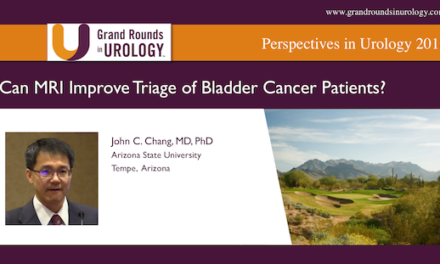Seth P. Lerner, MD, presented “Risk-Adapted TURBT” at the 26th Annual Innovations in Urologic Practice on September 15th, 2022.
How to cite: Lerner, Seth P. “Risk-Adapted TURBT” September 2022. Accessed Oct 2024. https://grandroundsinurology.com/risk-adapted-turbt-seth-lerner/
Risk-Adapted TURBT – Summary
Seth P. Lerner, MD, Professor of Urology and Vice-chair for Faculty Affairs in the Scott Department of Urology, and Director of Urologic Oncology and the Multidisciplinary Bladder Cancer Program at Baylor University, discusses risk-adapted transurethral resection of bladder tumor (TURBT) and its role in staging and treatment. Dr. Lerner opens by summarizing American Urological Association (AUA) guidelines on initial diagnosis of TURBT, namely clinical principle and expert opinion, and explains risk-stratification. He next discusses re-resection, emphasizing re-resection of high-grade T1 patients. Dr. Lerner first examines TURBT in low-risk patients. He recommends TURBT only and establishes the standard of care to be perioperative single dose intravesical chemotherapy using gemcitabine. He explains en-bloc TURBT, which should be considered with tumors up to two and a half centimeters. Dr. Lerner begins to examine intermediate risk in multifocal and/or recurrent low-grade disease. He outlines the standard of care as intravesical chemotherapy, and once again recommends TURBT only in these patients. Dr. Lerner warns against using Bacillus Calmette-Guerin (BCG) in these patients, as per AUA guidance. Dr. Lerner discusses treatment in high-risk cases, recommending in-office biopsy and TURBT including detrusor muscle. BCG induction and maintenance is standard of care in these cases. Dr. Lerner addresses BCG unresponsive patients and staging prostatic urethra. Next, he discusses muscle invasive bladder cancer (MIBC). Dr. Lerner addresses risk factors for extravesical and occult metastatic disease, including 3-dimensional mass, and hydronephrosis. Dr. Lerner introduces the Vesical Imaging-Reporting and Data System (VI-RADS), a useful tool in staging, before discussing staging in MIBC patients. In MIBC cases, cT0 does not necessarily predict pT0 at cystectomy. Dr. Lerner briefly introduces bladder preservation and outlines how it may become a staple of care in the future. He details how maximal TURBT is involved in both bladder preservation and chemoradiation therapy.
About The 26th Annual Innovations in Urologic Practice:
Presented by co-chairs Mohit Khera, MD, MBA, MPH, and Michael Coburn, MD, FACS, the Innovations in Urologic Practice conference provides a detailed review and commentary on multiple genitourinary and urologic diseases. Among the featured oncological topics are bladder cancer and immunotherapies, as well as upper tract cancer management, prostate cancer, including state-of-the-art imaging, focal therapy, and MRI. Experts also discuss new tools and techniques for nephrectomy and treating advanced renal cell carcinoma. In terms of general urological approaches, the conference also includes pelvic reconstruction and trauma; men’s health topics like male infertility, andrology, and sexual dysfunction; OAB and voiding dysfunctions; and ways to diagnose and treat infections in the urology patient.
For further educational activities from this conference, visit our collection page.
ABOUT THE AUTHOR
Seth P. Lerner, MD, FACS, is Professor of Urology and Vice-Chair for Faculty Affairs in the Scott Department of Urology at the Baylor College of Medicine in Houston, Texas. He holds the Beth and Dave Swalm Chair in Urologic Oncology. Dr. Lerner is the Director of Urologic Oncology and the Multidisciplinary Bladder Cancer Program, also at Baylor.
Dr. Lerner earned his medical degree from the Baylor College of Medicine, completed a surgical internship at Virginia Mason Hospital in Seattle, and returned to Baylor for his residency training. He completed a two-year fellowship at the University of Southern California in Urologic Oncology and Reconstructive Surgery and joined the full-time Baylor faculty in 1992.





